Blog Archives
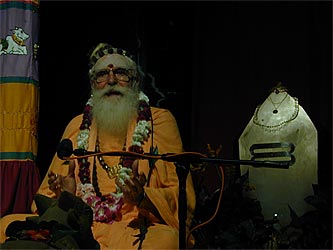
Gurudeva speaks in Kadavul temple. Bodhinatha continues the tradition, same time, same place, same station, “the Kailasa Parampara, 1008 on your dial.”
It was Sun Four today and the Siddhidata Kulam gave it’s phasely report. At the temple site focus is on the next lift of five beams to the top of the temple and making preparations for the arrival of the next container of stones which has arrived in Honolulu and will be on Kauai shortly. The team has of course been working on their usual chores, lots of electrical, plumbing, vehicle repairs, oversees contractors behind hired for different jobs and of course, the garden and grounds.

Now that Sadhu Paksha is over, we are hosting guests again as usual.
Krishnan and his wife, Jayashree, visited from Seattle with their daughters. Sneha and Pooja. Jayashree’s brother had visited us last year and recommended to them that they visit Kauai Aadheenam during their Hawaiian vacation. After their tour they had a wonderful visit with Bodhinatha. They asked some very insightful questions and received some great answers. It is nice to see couples like this take advantage of the rare time with a satguru to clarify the questions of life.
 |
 |
 |
 |
 |
 |
||||
Click for most recent TAKA page with an Iraivan Temple progress update. |
||||

Both Krishnan and Jayashree speak Tamil so they had a nice wonderful chat with Shanmugam stapathi and the silpis.
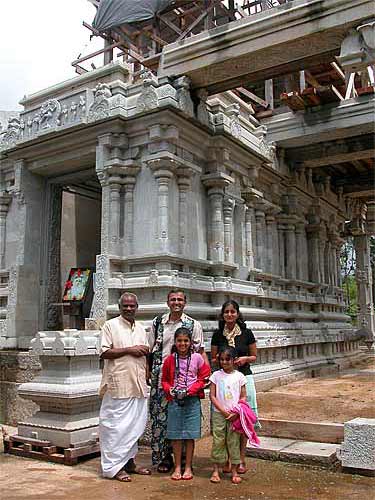
They were very much impressed with
Iraivam and the surroundings and had not expected to find such a place.

Carving on the bottom side of the top pieces of the pillars. We are actually seeing here the square “peg” that will fit into a square hole at the top of the pillar. The job of flipping this stone over, in preparation for being placed on top of the pillar can take half a day! Our Siddhidata Kulam will be talking with our crane operator to see if we can find a way to turn these huge stones over with his help.
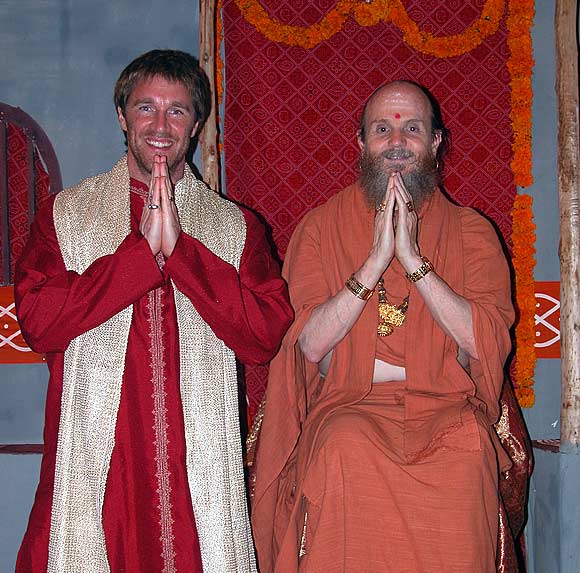
Innersearcher Gerard Linsmeier took a break from his successful but very intense business life in California. He’s a veteran spiritual seeker having taken such trips as tours with Essenes to Egypt, and he has studied a lot of Buddhism. He saw this innersearch as an opportunity to make a break with his old life and chart a new course for his spiritual evolution. He always had a strong, bright presence and we appreciated very much his clear focus on spiritual realization as the goal of life. That is of course the purpose of human birth and Gerard knows it. Not having had much exposure to Gurudeva’s teaching previously, his questions helped to draw out from the monks articulations of the teachings in ways that work for the uninitiated. Not everyone asks you to differentiate between Savikalpa and Nirvikalpa samadhi! He was a great addition to our satsang of pilgrims. We wish you God speed in your spiritual search.
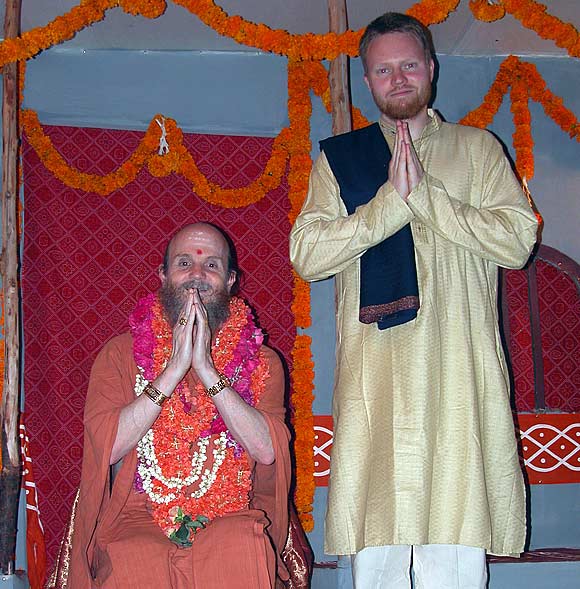
Another committed soul on the path, — this is Geir Thore Berge, from Norway. He’s been studying Gurudeva’s teachings for several years. This is his first personal contact with us. He’s been in touch with other spiritual teachers and take his inner life very seriously. We appreciated his quiet, thoughtful approach. Come visit us on Kauai one day, Geir!
 |
Himalayan Academy Travel Study Programs |
Images from the Recent 2004 Indian OdysseyJanuary 19, 2004 – February 5, 2004 Bangalore, Madurai, Tanjavur, Chennai and |
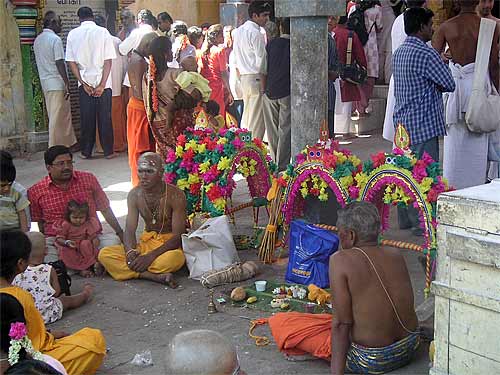
Vignettes from Palani Hills. Kavadi carriers have arrived at last at the top of the hill, radiant from the purification of their tapas.

Another troup of Kavadi carriers are the bottom of the hill, ready to make the ascent…

Sadhus everywhere…

It is the great gift of India to be immersed in a society where spiritual and religious life is front and center for a very large percentage of the population. The presence of renunciates flowing silently here and there through society is a blessing. One is never far from the awareness of ones true purpose in life and the ultimate goals of existence.
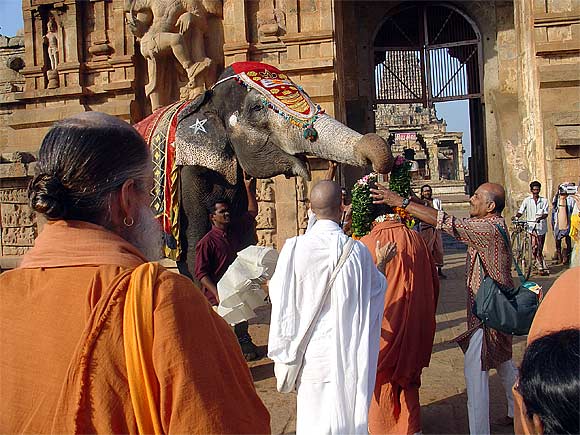
The elephant of Tanjavur’s Big temple give Bodhinatha a garland.
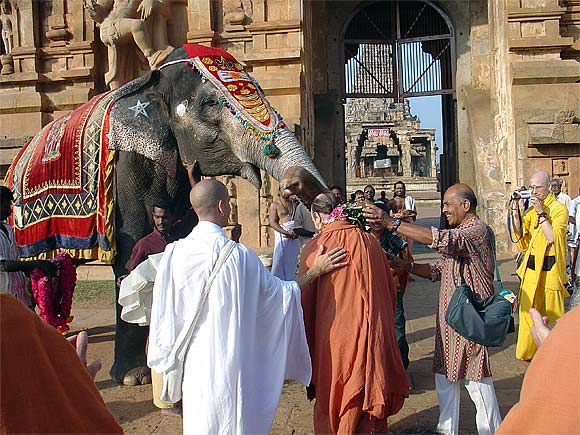
Then blesses him with a quick touch of the trunk on the top of the head. On the right is Nellaiappan who has done so much to make this innersearch a success.

It is customary to give the elephant a rupee note, which he passes back to the mahout– a contribution to the elephant’s care and maintenance.
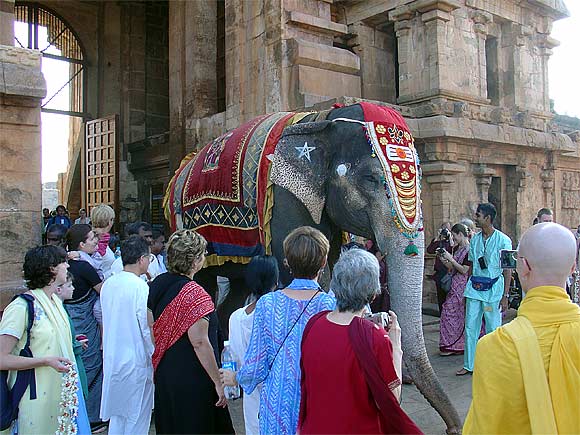
The beautiful creature leads the parade.

In another town, the temple elephant makes it’s traditional rounds of the streets of the town. He (or she) blesses each of the shops and homes.
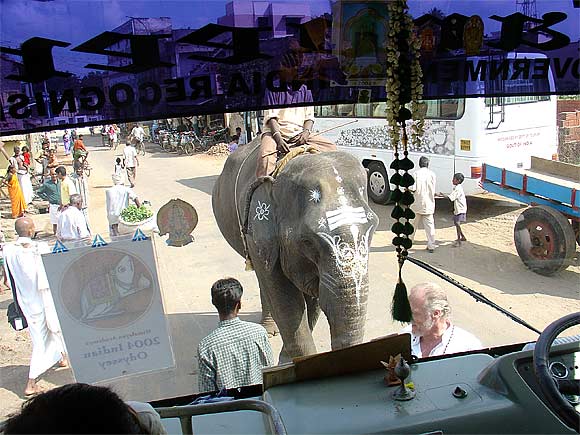
He comes to bless our Innersearch bus.

Gurudeva with the famed “Mr. Murthi” who was our previous Liason Officer in India for many years before his passing. There was nothing this man could not get done. Nellaiappan now fulfills that post and it sometimes seems there is also nothing that he cannot get done as well!
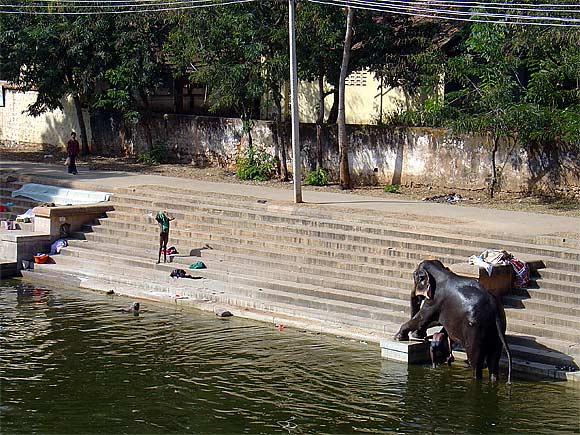
Mahout an his elephant take their morning bath.
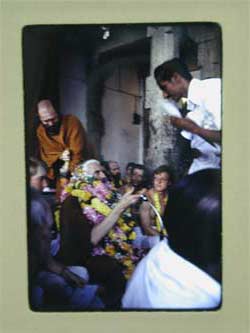
Gurudeva speaks at another temple on the 1982-83 Innersearch.
No Audio Today
|
Take this opportunity for an adventure. Close your eyes and click to get a message picked at random from the vast audio archives of our Satgurus’ discourses |
And click here for an Index to All Past CyberTalks. Study Gurudeva’s teachings. Visit the Master Course site! |
| FULL INDEX OF 650+ CYBERTALKS
 |
|
Study Gurudeva’s teachings.
|
transcription begins
Date: February_22_2004
Title: Work Is Worship
Category: Good Conduct
Duration: 13 minutes 60 seconds
Date Given: January 9, 2004
Given by: Bodhinatha
Good Morning, everyone! We welcome our two guests this morning, we are happy to have you with us.
We have a short talk as part of our program. We are preparing for our journey to India. We have a group of about 90 people altogether counting our staff, heading off to India in a few days. To the temples and some of the monasteries in Tamil Nadu. One of our stops toward the beginning is at our Iraivan Temple carving site, our work site in Bangalore. We will have a very special event there one evening.
So I was trying to choose an appropriate topic. This is the talk that is going to be given there. I don’t have time to make two talks, one for today and one for then!
The natural subject I thought of is, it is a work site so, work is worship made sense to me. Work is worship. So that is the title of this talk, ‘Work Is Worship’ .
The concept that work is worship has many aspects to it. To some people work and worship are totally separate. Worship is what is done in the temple and in the shrine room. Work is what is done in the fields, the factory and the office. They are completely separate. We are working to earn money to support ourselves. We are worshipping to receive the blessings of the Gods. The two have no relationship.
What is it then that transforms work from a secular pursuit into a religious one?
It is an overview that is through the process of living life that we unfold spiritually. It is through fulfilling our natural duties in life, honestly and to the best of our ability that spiritual progress is made. Work puts us in situations that we interact with other people. In doing so, we work through the karma we created in the past and create new karma to be faced in the future. In interacting with others we learn important lessons and as a result improve our behavior and become a more spiritual person.
With this in mind, we can see that pujas in the temple and our daily work are both contributing importantly to our spiritual progress. There is a quote from Paramaguru Yogaswami which captures the essence of this perspective, “All work must be done with the aim of reaching God.”
Isn’t that nicely said? All work must be done with the aim of reaching God. So, nothing we do is separate from that purpose.
In fact, today is Yogaswami’s nakshatra – Aslesha, so it is the monthly Guru puja day for Yogaswami. So, it is nice that he gets to say a few things. He has about four little statements here. ( to make.
The second idea.)
Let us develop a second idea on how work is worship. This is the idea that work is dharma. Fulfilling our religious duties in life, we all have certain duties in life. It is the duty of children to go to school and become educated. It is the duty of adults to earn an income and raise the children. Our natural profession in this life is based on the professions we have fulfilled in our past lives, plus the karma we bring into this life. This is called our svadharma and fulfilling it to the best of our ability causes us to make spiritual progress. The idea is if we are challenged by the demands of our natural profession but have within us the ability to rise up and meet those challenges successfully.
Here is a quote from Yogaswami to illustrate this point as well, “Do your work. Work is svadharma, following your path.”
Next, a third idea for work is worship.
The idea is that we can integrate certain religious practices into our work routine which bring blessings to it and give it a more spiritual atmosphere.
For example, a shop keeper has a shrine to Lord Ganesha in the corner of his shop, does a puja there every morning asking Ganesha to bless his business for that day.
In a stone workshop such as this one, a puja is done before carving on a new stone, to remove negative forces and obstacles. In this way we are integrating worship into our work place environment. Gurudeva tells us, “Lord Ganesha influences events slowly and subtly, in unseen ways. Situations will change for you. unexpected doors will open and the accustomed ones will close as you are propelled through His grace towards your inevitable glorious future.”
A fourth way that work is worship is the idea of selfless service.
This is a concept of helping others in a selfless way, performing actions for which we receive no personal benefits, whatsoever. Benefits are usually in the form of money or prestige. This is most commonly referred to as karma yoga, union through service. Karma yoga produces spiritual progress in that certain past negative karmas can be mitigated, meaning lessened, as well as new positive karmas created for the future.
Selfless service is also an excellent way of overcoming the instinctive tendency of selfishness, being totally self centered and only concerned about oneself. It is interesting to note that the unique relationship between selfishness and happiness. The more selfish we are, the less happy we are and the less selfish we are, the happier we are. So they are in opposite.
Gurudeva gives an excellent explanation of the benefits of karma yoga, “Go out into the world this week and let your light shine through your kind thoughts. But let each though manifest itself in a physical deed in doing something for someone else. Lift their burdens just a little bit and unknowingly perhaps you may lift something that is burdening your mind. You erase and wipe clean the mirror of your own mind through helping another. They call this karma yoga, the deep practice of unwinding through service the selfish, self centered egoistical vasanas of the lower nature that have been generated for many, many lives and which bind the soul in darkness. Through service and kindness, you can unwind the subconscious mind and gain a clear understanding of all laws of life. Your soul will shine forth. You will be that peace, you will radiate that inner happiness and be truly secure simply by practicing by being kind in thought, word and deed.”
The fifth concept of work is worship is in the concept of Sivathondu, which is the idea that is akin to karma yoga in our tradition of Saivism.
Sivathondu means service to Siva and one who performs this service is called a Sivathondar or Sivanadiyar which literally means a devoted servant of God Siva, who regularly performs selfless work in service to others.
Sivathondar or Sivanadiyar also conveys a mystic relationship to between the devotee and God Siva in which all spiritual and mental and physical actions are perceived as fulfilling the will and design of Siva.
There is an important statement by Paramaguru Yogaswami on Sivanadiyar, “We are Sivanadiyar, we are Sivanadiyar, we are Sivanadiyar, we are Sivanadiyar. This is charya, this is kriya, this is yoga, this is jnana, this is mantra, this is tantra, this is the panacea.”
What Yogaswami is stressing in this statement is of course that the core attitude of being a devoted servant of God Siva is the key to making progress on Saivism’s spiritual path.
The sixth concept of work is worship, is that in Saivism the first stage of practice is called the charya pada. It is also called the dasa marga meaning, the path of servitude. For here the soul relates to God as servant to Master, which is the idea of Sivathondu which we were just speaking about.
Charya is the performance of altruistic religious service and living according to traditional, ethical conduct and culture, by which the outer nature is purified. It is the stage of overcoming basic instinctive patterns. The keynote of charya or karma yoga is seva, religious service given without the least thought of reward, which has the magical affect of softening the ego and bringing forth the soul’s innate devotion.
There is an excellent quote from Tirumular’s Tirumantiram describing the temple duties of those following charya. “The simple temple duties of lighting the lamps, picking the flowers and lovingly polishing the floors, sweeping, singing the Lord’s praise, ringing the bells and fetching ceremonially water, these constitute the dasa marga.”
The seventh and final idea on work is worship has to do with how the skills we develop in our outer life are useful in our inner life as well.
For example, if we develop the habit of good concentration in our school studies as a youth and carry this on in our adult life by being totally focused on the tasks that we do at work, we have developed a strong ability to concentrate. Therefore when you sit down to meditate, our thoughts are naturally concentrated and it is easy to control the mind. However, if as a child we let our mind wander during our studies and as an adult daydream a lot while working, when we sit down to meditate it will be impossible to control our thoughts.
Another important ability to develop in our work is willpower. Willpower is the strength of will to carry out one’s decisions, wishes or plans. People who regularly make plans and fail to carry them out lack willpower.
For example, a student often plans to get up early to study for his or her test but always when the time comes decides to continue sleeping in, instead.
Willpower can be cultivated by finishing and doing well, every task that we undertake. In fact, done a little better than our exceptions. First- finish each task. Second- do it well. Nothing is done with half our mind thinking about something else, nothing is dropped in the middle. Developing these two important habits produces an indomitable willpower. A strong willpower can be turned within and help us immensely in our inner pursuits such as meditation. But first it must be developed externally. Strong willpower is also helpful in being able, in general, to better control the instinctive and intellectual mind.
Gurudeva has an insightful comment on willpower. “The more you use your personal, individual willpower, the more willpower you have.”
In summary we have looked at six different ways in which work is worship.
First, through holding the overview that it is through the process of living life that we unfold spiritually. Second, that work is dharma. Fulfilling our religious duties in life. Third, we can integrate certain religious practices into our work routine which brings blessings to it and give it a more spiritual atmosphere. Fourth, that work includes karma yoga, selfless service. Fifth, that selfless service gives rise to the attitude of being a devoted servant of God Siva, dedicated to helping others. Sixth, that work includes performing religious service at the temple. Seventh and finally, that concentration and willpower developed in our work are useful in striving to meditate, as well as, in controlling the instinctive and intellectual mind.
Aum Namah Sivaya.
transcription ends
|
MORE UPLIFTING THINGS |
Color Trilogy Complete! We are happy to announce that the new edition of the enormously popular Dancing with Siva is now available in hard back with all new color artwork. It’s truly an amazing and beautiful work, with more art than any of the collection. This completes the fulfillment of the vision that Gurudeva had of his Master Course Trilogy being produced in full color. In addition, Bodhinatha is taking pro-active steps to bring Gurudeva’s teachings out in a new forms that can be broadly disseminated in the mass mind. With this in mind we, are also pleased to announce that the Dancing with Siva pocketbook is also available. Keep the three-pound book in your shrine room, and take the little one with you on the airplane or subway! How little? It’s just 3″ by 4.5″ — truly pocket-sized, and just over half an inch thick. Yet it is a full 375 pages, containing ALL of the 155 sutras. Available now at our online store. The complete Trilogy is being offered at a discount. |
|

|
View the fabulous full-color PDF’s of the latest edition of Island Temple Magazine, and order copies if you don’t have one. | |
|
1. SIGN OUR GUESTBOOK and receive a FREE GIFT |
||
| 2. Newest Book: DANCING WITH SIVA — Pocketbook | ||
|
3. Visiting KAUAI’S HINDU MONASTERY |
||
|
4. Contribute to THANK YOU, GURUDEVA FUND |
||
From Our Gurus' Teachings
Archives are now available through 2001. Light colored days have no posts. 1998-2001 coming later.
